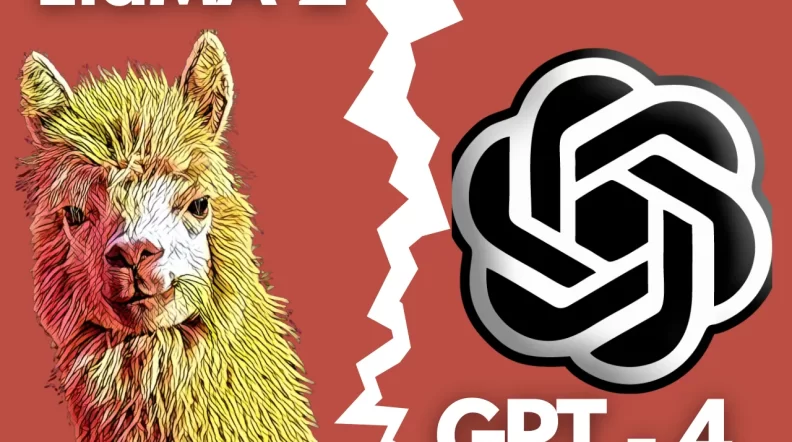Llama 2 vs GPT4: A Comprehensive Comparison of AI Titans






In the dynamic world of artificial intelligence, Llama 2 and GPT-4 stand out as leading models, each bringing unique strengths to the table. Llama 2 performs admirably in generating creative text, showcasing its prowess in complex tasks with impressive accuracy. On the other hand, GPT-4, an advanced model with a vast parameter count, excels at generating text that mirrors human-like quality, making it a formidable contender in the AI arena.
While Llama 2 offers an open-source advantage, making it widely accessible for experimentation and innovation, GPT-4’s closed-source nature, backed by OpenAI, provides unparalleled performance in generating creative and nuanced text. The choice between these giants depends on the specific needs, whether it’s for generating creative content or tackling complex tasks with high accuracy.
Introduction to the AI Giants
OpenAI’s ChatGPT and Llama 2 have revolutionized the way we think about artificial intelligence. With their ability to generate human-like text, they’ve opened up new possibilities for interaction and automation, setting new standards for what AI can achieve in natural language processing.
Llama 2: The Open Source Challenger
Llama 2 emerges as a formidable open-source challenger, leveraging the power of natural language processing to understand and generate human-like text. Its accessibility and flexibility make it a favorite among developers and researchers looking to push the boundaries of AI.
GPT-4: The Pinnacle of Closed-Source AI Models
GPT-4, developed by OpenAI, represents the pinnacle of closed-source AI models. Its sophisticated design and vast knowledge base enable it to perform a wide range of tasks with remarkable proficiency, setting a new benchmark for what artificial intelligence can achieve.
Understanding the Architectures
At the heart of these AI titans lies their reliance on vast amounts of text data. This foundational element is crucial for training the models, allowing them to understand and generate human-like text with a level of complexity and nuance that was previously unattainable.
Diving Deep into Llama 2’s Structure
The structure of Llama 2 builds upon the legacy of its predecessor, Llama 1, by enhancing its ability to process and understand natural language. This progression demonstrates a significant leap in AI development, pushing the limits of what open-source models can achieve.
Exploring the Intricacies of GPT-4’s Design
GPT-4’s design is a masterpiece of engineering, incorporating intricate layers and mechanisms that allow it to understand and generate text with unprecedented accuracy and creativity. Its architecture sets a high standard for future AI models.
Technical Showdown: Llama 2 vs GPT-4
The comparison between Llama 2 and GPT-4 goes beyond mere capabilities, delving into the technical core of each model.
Model Size & Parameter Comparison
Llama 2 boasts 70 billion parameters, a testament to its complexity and potential for understanding nuanced language. In contrast, GPT-4’s model scales to a staggering trillion parameters, offering an even deeper understanding of language and context.
Training Data Insights: How AI Learns
OpenAI’s ChatGPT, the technology behind GPT-4, utilizes a diverse range of training data, equipping it with a broad understanding of human language. This extensive dataset is key to its ability to generate highly accurate and contextually relevant text.
Architectural Innovations and Differences
Both models showcase architectural innovations that enhance their computational agility. These advancements are pivotal in achieving high accuracy and inference speed, setting new benchmarks for efficiency in AI language processing.
Inference Speed & Efficiency: The Speed of Thought
The computational agility of Llama 2 and GPT-4, coupled with their architectural innovations, results in remarkable inference speed. This efficiency allows them to process and generate text at the speed of thought, demonstrating their advanced capabilities.
Performance and Usability
The Llama 2 70b model sets a new standard for performance and usability in the realm of artificial intelligence.
Benchmarking AI: The Numbers Game
When it comes to benchmarking AI, the numbers tell a compelling story of capability and performance.
Llama 2’s Benchmark Scores
Llama 2’s benchmark scores reflect its robust performance, particularly in tasks requiring creative text generation and complex task accuracy. These scores highlight its standing as a highly efficient and versatile AI model.
GPT-4’s Performance Metrics
GPT-4 showcases impressive performance metrics, setting new standards in natural language processing tasks. With its advanced algorithms, GPT-4 outperforms previous models in understanding and generating human-like text. It demonstrates remarkable accuracy in translation, question-answering, and summarization, making it a leader in AI language models. Such capabilities ensure GPT-4’s dominance in creating sophisticated AI applications, from chatbots to content generation, by understanding context better than ever before.
Usability Across Different Domains
GPT-4’s versatility extends across various domains, requiring minimal coding skills for integration. Its ability to process and generate natural language makes it invaluable for developers, marketers, and content creators alike. This ease of use democratizes AI, enabling a wide range of applications from automated customer service to personalized content creation, without the need for deep technical expertise.
Platform and API Accessibility
GPT-4’s platform and API are designed for easy accessibility, allowing developers to seamlessly integrate its capabilities into their applications. With comprehensive documentation and support, it caters to both experienced programmers and those new to AI development. This accessibility fosters innovation, enabling the creation of advanced applications that leverage GPT-4’s powerful language processing features.
Community Support and Open Source Contributions
The community around GPT-4 actively contributes to improving and expanding its capabilities through open-source contributions. By sharing knowledge, tools, and models, the community plays a crucial role in advancing the technology. This collaborative environment not only enhances GPT-4’s functionality but also encourages the development of new AI applications, benefiting users and developers worldwide.
Addressing the Real-World Applications
GPT-4 and Llama 2 are revolutionizing real-world applications with their advanced language understanding and generation capabilities. From automating customer service interactions to creating engaging content, these models are transforming industries. Their impact is seen in how businesses optimize operations, personalize experiences, and innovate, proving the immense potential of AI in today’s digital landscape.
Practical Applications in Today’s Digital Landscape
Both Llama 2 and GPT-4 are integral in shaping the digital landscape through their advanced natural language processing. They empower applications in content generation, customer service, and more, showcasing the practicality of AI in diverse fields. Their capabilities enable more personalized and efficient digital experiences, marking a significant step forward in technology’s role in society.
Llama 2 in Creative Content Generation
Llama 2, with its 70B parameters, excels in generating content that is both innovative and relevant. Its open-source nature allows for vast experimentation and customization, making it a go-to for creators looking to produce unique and engaging material. From writing articles to crafting stories, Llama 2’s prowess in content creation is unmatched, offering a glimpse into the future of automated creativity.
GPT-4 and Its Impact on Chatbots
GPT-4, as a powerful language model, has significantly advanced the development of chatbots. Its deep understanding of context and nuance enables the creation of chatbots that can engage in more natural and meaningful conversations with users. This has improved customer service experiences across the board, making interactions smoother and more human-like, thereby transforming how businesses connect with their audiences.
The Innovation and Limitations
As AI continues to evolve, both Llama 2 and GPT-4 are at the forefront of this innovation, pushing boundaries in natural language processing. However, they also face limitations, including challenges in ensuring the ethical use of technology and managing the vast amounts of data they require. Addressing these limitations is crucial for the responsible advancement of AI.
Pushing the Boundaries: Where Each Model Shines
Llama 2 and GPT-4 each boast unique strengths; Llama 2’s open-source advantage and 70B parameters offer unparalleled accessibility and customization, while GPT-4’s natural language processing capabilities set new benchmarks in AI performance. These models are pushing the boundaries of what’s possible in AI, driving innovation across multiple sectors.
Llama 2’s Cost Efficiency and Open-Source Advantage
Llama 2 offers significant cost efficiency and an open-source advantage, making it accessible to a wide range of users. Unlike its predecessors, including Llama 1, its open-source nature allows for greater experimentation and collaboration, fostering innovation in the AI community. This model democratizes access to cutting-edge AI, enabling more developers to create advanced applications without prohibitive costs.
GPT-4’s Unmatched Creativity and Flexibility
GPT-4 stands out for its unmatched creativity and flexibility in generating human-like text. Its sophisticated algorithms allow it to adapt to various styles and formats, making it ideal for a wide range of applications, from creative writing to technical documentation. This level of versatility is unparalleled, showcasing the potential of AI to mimic and augment human creativity.
Recognizing the Constraints
Despite their advancements, both Llama 2 and GPT-4 encounter constraints, including the ongoing challenge of addressing bias within AI models. Ensuring these technologies are developed and used responsibly remains a priority, as their impact on society continues to grow. Recognizing and addressing these constraints is essential for the ethical advancement of AI.
Addressing Bias and Ethical Concerns
Both Llama 2 and GPT-4 face scrutiny over bias and ethical concerns. Efforts are underway to mitigate these issues, focusing on creating more inclusive and representative AI systems. This includes refining training data and implementing fairness measures to reduce bias, ensuring these models can be used responsibly across all sectors.
The Challenge of Maintaining Privacy and Data Security
The open-source nature of Llama 2 and the proprietary aspects of GPT-4 and GPT-3 present unique challenges in maintaining privacy and data security. As these models process vast amounts of data, ensuring the protection of sensitive information is critical. Ongoing efforts to enhance security protocols and privacy measures are vital in maintaining user trust and compliance with global data protection regulations.
Detailed Comparison and Use Cases
When to Use Llama 2 Over GPT-4
Llama 2 shines in environments where open-source flexibility and cost efficiency are paramount. It’s the tool of choice for developers and startups looking to customize and experiment without the financial burden associated with closed-source models. With its open-source nature, Llama 2 encourages innovation and adaptation, making it ideal for projects that require a high degree of customization and community support.
The Superior Choice for Creative Content: A Closer Look
When it comes to generating content, GPT-4 often takes the lead, especially in tasks requiring sophistication and a nuanced understanding of language nuances. Its advanced algorithms and extensive training allow it to produce high-quality, creative outputs that can closely mimic human writing. This makes GPT-4 an excellent choice for industries relying heavily on creative content generation, such as marketing and entertainment.
Building Efficient Chatbots: Llama 2 vs GPT-4
In the realm of chatbot development, the choice between Llama 2 and GPT-4 often boils down to a balance between speed and efficiency. Llama 2, with its open-source adaptability, allows for more tailored optimizations to specific use cases, potentially offering faster response times in specialized applications. On the other hand, GPT-4, with its vast knowledge base, excels in understanding and generating more complex interactions, making it suitable for more generalized chatbot applications.
Beyond the Hype: The Future of AI Language Models
The landscape of AI is evolving rapidly, with models like OpenAI’s ChatGPT at the forefront of innovation. These advancements signal a future where AI can understand and interact in more human-like ways, breaking down barriers between technology and natural human communication. As these models learn and grow, they promise to revolutionize how we interact with digital systems, making technology more accessible and intuitive for everyone.
The Evolving Landscape of AI Development
Models like Llama 2 represent a significant shift towards more open, collaborative development in the AI field. This move not only democratizes AI, making powerful technology available to a wider audience but also accelerates innovation by tapping into the collective knowledge of the global developer community. As these trends continue, we can expect AI technology to become more versatile, powerful, and aligned with human needs and values.
Llama 2 vs GPT-4: Predictions and Expectations
The competition between Llama 2 and GPT-4 is driving rapid advancements in AI, with each model pushing the boundaries in different directions. As Llama 2 champions open-source accessibility and flexibility, GPT-4 continues to refine what’s possible in terms of quality and complexity of output. Looking forward, we anticipate both models will influence how AI is integrated into everyday technologies, from improving personalized digital assistants to creating more responsive and intelligent automation solutions.
Frequently Asked Questions
Curiosity about Llama 2 and GPT-4 spans a wide array of topics, from their capabilities in understanding and generating text in multiple languages to their performance on tasks like summarization and creative writing. With Llama 2 trained on a massive dataset, including 20 languages, and GPT-4 boasting 70 billion parameters, the scope for applications is vast. Both models excel in generating high-quality texts with minimal human oversight, each with its strengths in handling complex NLP tasks like the HumanEval coding benchmark, showcasing their revolutionary potential in various fields.
Unraveling the Mysteries of Llama 2 and GPT-4
Both Llama 2 and GPT-4 stand out for their factual accuracy and ability to generate high-quality texts, making them invaluable tools across many domains. While GPT-4, with its extensive training, excels in producing sophisticated, nuanced text, Llama 2 offers unparalleled flexibility and adaptability thanks to its open-source model. This makes both models highly effective in academic, creative, and technical writing, where the accuracy and quality of content are crucial.
Insights from AI Experts
AI experts highlight the transformative impact of models like Llama 2 and GPT-4 on customer service, predicting a future where AI-driven interactions are indistinguishable from those with human agents. The efficiency, scalability, and 24/7 availability offered by these models can significantly enhance customer experience, making them essential tools for businesses looking to stay competitive in a digital-first world.
Llama 2 vs GPT-4: Deciding the Best Fit for Your Needs
Analyzing Costs, Accessibility, and Performance
Choosing between Llama 2 and GPT-4 involves considering factors like budget constraints, the need for customization, and performance requirements. Llama 2’s open-source model offers a cost-effective solution with high adaptability, while GPT-4’s proprietary nature guarantees cutting-edge performance, albeit at a higher cost. Decision-makers must weigh these aspects to select the AI model that best aligns with their project goals and resources.
Making the Informed Decision: Which AI to Adopt?
Adopting the right AI model depends on specific needs, including the desired level of natural language understanding, budget limitations, and the scope of application. For projects requiring high customization or limited funding, Llama 2 provides a versatile, cost-effective option. Conversely, for endeavors where advanced language capabilities and sophisticated vocabulary are crucial, GPT-4 offers unparalleled performance, making it the go-to choice for premium, high-quality outputs.
Final Analysis: Which Model Takes the Crown?
Llama 2 vs GPT-4: The Verdict on the Ultimate AI Model
In the showdown between Llama 2 and GPT-4, the ultimate victor depends on the criteria used for judgment. Llama 2’s open-source language model and the backing of Meta AI highlight its strengths in accessibility and innovation, making it a champion for developers seeking flexibility and cost efficiency. On the other hand, GPT-4, supported by Meta and Microsoft, represents the pinnacle of advanced language models, excelling in generating sophisticated, nuanced text. GPT-4’s performance in benchmarks and its ability to process text in multiple languages underscore its potential to revolutionize a myriad of applications. Thus, while Llama 2 offers an open platform for widespread innovation, GPT-4 stands as the most advanced, albeit expensive, language model available, making it the preferred choice for applications requiring the highest quality of natural language understanding.